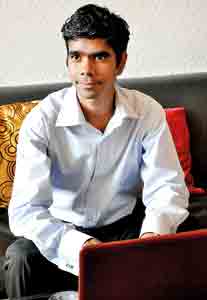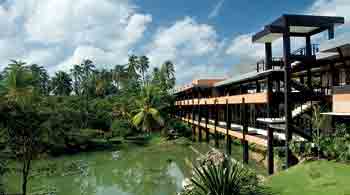For a garment that could be charitably described as ‘skimpy’, a bra can be remarkably complex. Into the making of one particular bra went a range of elastics, lace and yarn; there were the cups and hooks, the embroidery and the underwire. In total, it added up to 21 components and 8 packing materials each of which was sourced from 12 different suppliers.
 |
| Vidhura
Ralapanawe. Pic by Susantha Liyanawatte |
Vidhura Ralapanawe knows these exact numbers because as the Manager of Sustainability and Communications at MAS Intimates, he was a key player in the team that calculated the exact carbon footprint of this bra and then found a way to offset it. The result was the world’s first Carbon Neutral Bra. Launched in Marks & Spencer’s stores in April this year, it belonged to an eco-friendly range of lingerie dubbed ‘Leaves’ and was produced in one of the world’s pre-eminent ‘green factories’ - MAS Intimates Thurulie.
These two projects combined have brought Vidhura and MAS a great deal of international attention. In fact, his work has catapulted Vidhura onto an extraordinary list. Along with four others, the 41-year-old is now in the running to become a ‘Cultural Engineer’ at the Honda Dream Factory. The shortlist, which was compiled by journalists at The Guardian newspaper in the UK, asks the public to vote for their favourite candidate – the one with the highest votes will become the 11th Cultural Engineer, joining the team of 10 for several sessions of creative conversations and problem solving.
A look at the current Cultural Engineers in The Honda Dream Factory stable makes it clear that this isn’t an exercise focused on designing better cars. Instead, there’s Simon Berry, who through his organization ColaLife succeeded in getting Coca Cola to distribute life saving medicines in Zambia, there’s David Hieatt who dreamt up the famous ‘DO’ lecture series and Mark Stevenson, founder of the League of Pragmatic Optimists. After he was stabbed, Oliver Hemsley founded ‘Art Against Knives’ – an anti-knife crime, youth-led initiative - with Katy Dawe. They and the others have little in common aside from a great capacity for finding unconventional solutions to real world issues and possessing the tenacity to implement them.
The chance to become one of the group represents a unique opportunity for Vidhura. “A few times in my past I’ve worked in spaces where people come together. What that does for you is amazing. It just changes your perspective, your understanding of what is possible,” he says. In a full-sleeved blue shirt, complete with chunky silver cufflinks, Vidhura would look comfortably corporate if not for the diamond stud glinting in one ear. The father of two says his career has been increasingly dedicated to finding ways to make business practices more environmentally sustainable and socially responsible by adopting creative solutions. “For me sustainability is primarily a design question,” he says. “Every step of the way you have to keep re-visualising it. You have to ask why.”
Having graduated from the University of Moratuwa with a degree in Engineering, he began his corporate career with IBM in New York. A burgeoning interest in sustainability led him to enrol for a Masters Degree in Responsibility and Business Practice at the University of Bath, UK. Moving between Sri Lanka and America, he helped set up Vidullanka’s first mini-hydroelctricity plant in Ratnapura and then worked with the International Research Institute for Climate and Society (IRI) at the Earth Institute of Columbia University in New York. There he researched and wrote on issues related to climate change, including drought modelling, downscaling Global Climate Model outputs for applications and disaster risk assessment within a Sri Lankan context.
 |
| From the M&S catalogue |
The making of a Carbon Neutral Bra |
To produce the Carbon Neutral Bra first required that the team chart the carbon footprint of each section of the bra’s life – from the sourcing of the raw materials, onto distribution and marketing and even further, into how customers would use and then dispose the product. (The last two required extensive questionnaires with women being questioned on how often they laundered their underclothes and how long they wore them before disposing them.) “This gave us a very granular picture of how the footprint was constructed,” says Vidhura.
This comprehensive ‘lifecycle footprint’ took nearly a year to complete, but the decision to break the process down into its component sections allowed them to really assess their weakest points and eliminate wastage. Lessons learnt here are already being applied to new products for Marks & Spencer’s. “It really gave us a big toolbox to work with,” says Vidhura.
Once the carbon footprint was reduced as much as possible it was time to buy the offsets. In theory, these would serve to balance out the fossil fuel and energy expenditure the bra would use over its lifetime. Working with Rainforest Rescue International (RRI), the team chose to focus on building a ‘biodiversity corridor’ between the Polgahakanda and Kinneliya Forest Reserves that would allow the movement of animals and ‘gene flow’ between the two. Nine farmers were chosen and 6500 trees, all indigenous species, were planted to create a real physical link. With the RRI to supervise, the farmers in charge will receive a monthly stipend for the next 20 years. Whatever produce is harvested from the trees will serve to supplement their income. In addition, the plants are GPS tagged and monitored regularly. |
When he eventually chose to return home with his family, it was to join MAS Intimates. As the leader of a large design team working under managing director, Dian Gomes, Vidhura contributed several essential concepts to the final plans for the Thirulie factory. “The question I often get asked is ‘Why does this factory look like an eco-hotel’?” Vidhura says. His response tends to be a question – “Why shouldn’t it?”
The design for the extraordinary building evolved out of an emphasis on the ‘human factor’. It’s why the canteen has the best view – overlooking a lake – and why cosier rooms flooded with natural light have replaced a giant production room.
Running on hydroelectricity and solar energy, Thirulie is such a model factory that it’s had designers from all over the world coming in to study it every single week since it first began operations 3 ½ years ago. “We designed the factory to be a centre for learning and inspiration,” Vidhura says, revealing that they’ve been happy to make their hard won knowledge widely available. “If you’re serious about sustainability you have to share your ideas.”
He describes the factory as far from perfect, but says it is nevertheless a big leap forward. With climate change and resource depletion set to abruptly curtail our current way of life, he believes companies and even countries must embrace such change if they are to survive the years ahead. “Just because we’re in Sri Lanka doesn’t mean we can’t be in the forefront of the transformation that is coming,” he says.
Though he believes the change must come at the level of global systems, Vidhura does what he can on a personal level. While the rest of Colombo pants in the heat, he lives in a 3,500 sq ft house that has been designed so that it doesn’t need a single fan or A.C to cool it. His family of four runs up a surprisingly modest electricity bill (approximately Rs.2,000 a month) and recycles and composts regularly. When he leaves for his next meeting today, it will be in a Toyota Prius. Aside from his work at MAS, he serves as a director of Co-Energi, a Sri Lankan energy services/sustainability consulting company run by his wife Magda.
Their services are increasingly in demand. Looking forward, Vidhura points out that the earth’s population will hit 9 billion people by 2050, with a majority of the populace based in cities. For him, the question is no longer of the crisis our children will inherit, rather it is the question of what we must do to transcend the crisis we are already in the throes of. “What will the city of the future look like?” he asks, sharing his belief that things like social justice and equity will have to be factored in.
“This is not just some Utopian ideal.” Of course, finding ways to translate these ideals into actual practice can be exhausting both emotionally and intellectually. “There are days when I’m like this,” Vidhura says, pretending to pull out his hair.
 |
| Inspiring workplace: The MAS Intimates factory at Thirulie |
“The problem is you keep bumping into reality all the time”: for instance, a solution might be too expensive or unimaginable with current technology. For Vidhura his response must be a combination of tenacity and flexibility: if this doesn’t work, what will?
He hopes working in the Honda Dream Factory will help him generate some of the answers to some difficult, yet essential questions. But however this turns out, Vidhura’s own words, part observation, part prophecy, are likely to hold true. As he likes to point out: “The future is interesting.’
You can vote for Vidhura at http://www.guardian.co.uk/honda-dream-factory/the-dream-factory-vote-for-the-next-cultural-engineer. Voting ends
on October 28, 2011.
|
